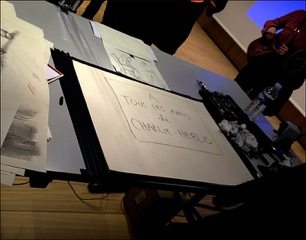Obviously and sadly, the major comics-related news today concerns the attack yesterday morning on the Paris headquarters of the French satirical magazine Charlie Hebdo. According to reports, masked gunmen entered the building and killed twelve people, including four cartoonists (Cabu, Tignous, Wolinski, and editor Stephane Charbonnier), and critically wounded at least four others. The attackers are still at large, but two of them have been officially identified by police. [UPDATE: The names of all twelve victims have now been released, and a fifth cartoonist was one of them: Honoré.]
It is still difficult to express the shock and dismay this event has provoked. We express our condolences and support to the family, friends, and colleagues of the victims.
Both the National Cartoonists Society and the Association of American Editorial Cartoonists have released statements about the attack.
There has been much good reporting on the event. The Guardian in particular has extensive, regularly updated coverage.
Bart Beaty has an excellent short piece on Slate called "What It Means to Be a Cartoonist in France". In the same magazine, Joshua Keating reports on the history of the publication and the likely context informing the attack.
There have been too many noteworthy responses to the attack to list them all here, but a few that stood out so far include pieces by Zunar, Jeet Heer, Arthur Goldhammer, Domingos Isabelinho, Matthias Wivel, Zainab Akhtar, and Ted Rall.
There is a lot we still don't know. We will have more coverage soon.
——————————————
Today, on the site we are publishing Ken Parille's first column of 2015, in which he names his choice for comics critic of the year. Last time he did this, Parille counterintuitively honored Fredric Wertham. Who's the winner for 2014?
The Internet seems to have brought into being a new type of critic: The Millennial Literalist. A product of the 21st-century’s asphyxiating instantaneous reaction culture, the ML’s motto is Read then Rant. They’ve been trained to see immediacy as an unquestioned value. (Think about how anxious we get — even pissed off — when someone doesn’t reply to our text within ten minutes, especially since we always reply to them in like under a minute!) Why reread, reflect upon, and reconsider our reactions to a work of art, all of which take precious time and may lead to mixed-up feelings and queasy uncertainty, when we can trust — and immediately globally disseminate — our first instincts? “The now” of unfiltered passion always indicates authenticity, and that’s what the world needs more of, right?
Unsurprisingly, immediacy generates a number of casualties. When MLs go after an online comic, for example, they trample over the hard to describe, not always obvious qualities that make it art in order to reduce it to an easy-to-attack message. MLs often interact with a comic as if it’s an expository prose essay expressed in a neutral, legalistic tone. Since it’s hard to pontificate in the presence of ambiguity, the ML ignores complexity, irony, playfulness, narrative perspective, drawing style, tone, etc., flattening art into ‘mere rhetoric.’ If not quite art’s enemy, the ML is, at best, its fair-weather friend. If a comic expresses their opinions in the correct way — the way they want and need it to — they’ll hype it on Twitter. But if not, watch out, artists! (If you’re a non-Millennial, don’t worry. This practice really isn’t the province of any ‘demographic.’ In this new century, with computers always in our back pockets, anyone can be a literalist.)
This will be a good one for the people who like to read skim quickly for the parts they can get outraged by without even attempting to empathize with the writer's viewpoint. Should be fun for Ken online today!
Meanwhile, elsewhere:
—More Best of 2014 Lists. These haven't slowed down much yet. This time, I have lists from Paul Gravett, Nerdist, and a variety of different comics folks recruited by Zainab Akhtar.
—Interviews & Profiles. Hillary Brown has a strong interview with the always fascinating Dylan Horrocks. Tim O'Shea talks to Mike Dawson.
—Reviews & Commentary. Panel Patter looks at Dash Shaw's coloring strategies. Ben Marks notes the publication of volume 3 of Walt Kelly's Pogo, in which we enter the strip's most famous era.
—Misc. Over the holiday, I missed this great Ivan Brunetti post about attempting to fill Ernie Bushmiller's shoes on Nancy. The critic Robert Boyd remembers his own youthful attempt to become a cartoonist.
—Podcasts. I missed many of these over the holiday break. At Inkstuds, I liked the interview with Tom Spurgeon. I haven't listened to the episode where Brandon Graham, Ed Piskor, and Joe Keatinge discuss the work of Rob Liefeld yet, but since I called for just that kind of thing from Liefeld fans a while back, I feel obligated to link to it and plan to listen soon. (I'm hoping none of them held my request against me...)
Make It Then Tell Everybody hosted Kevin Huizenga, Hope Larson, and Josh Bayer.
At Comic Books Are Burning in Hell, Once, Current, and Future TCJ contributors Tucker Stone, Joe McCulloch, Chris Mautner, and Matt Seneca discuss their favorite comics of 2014.






